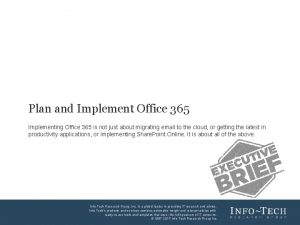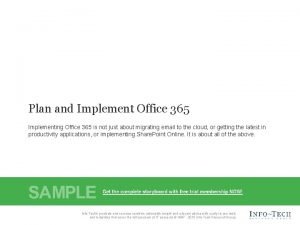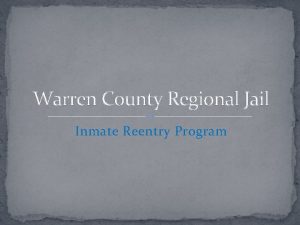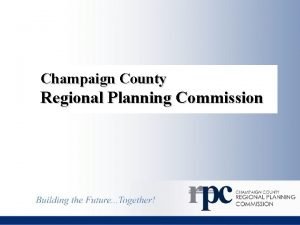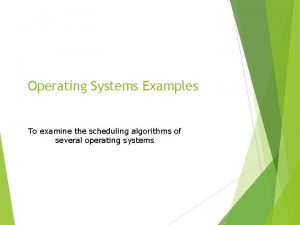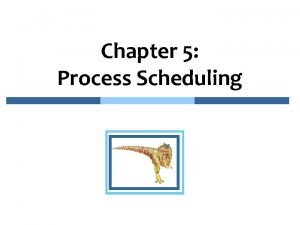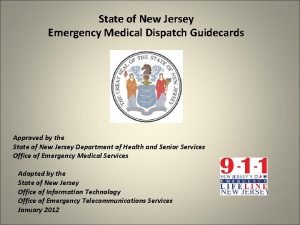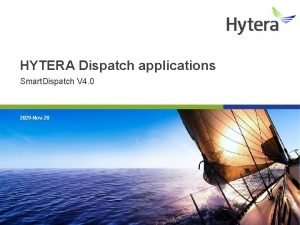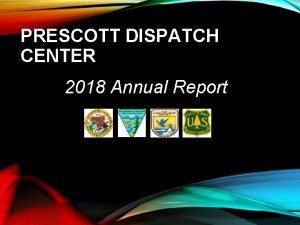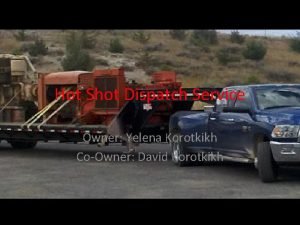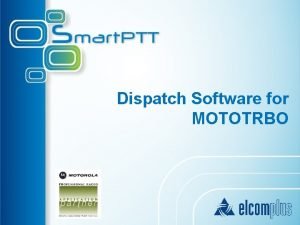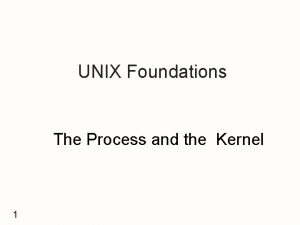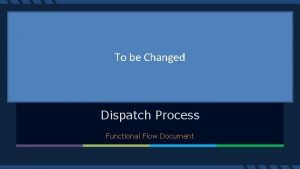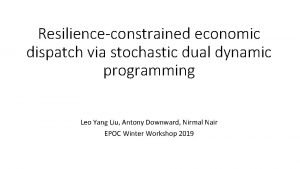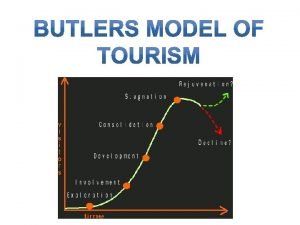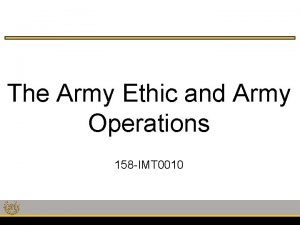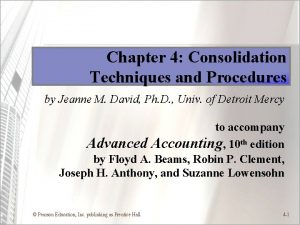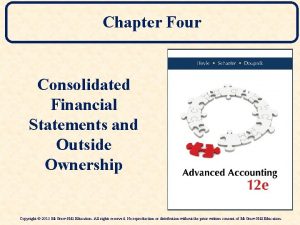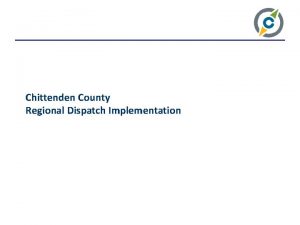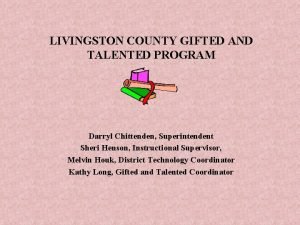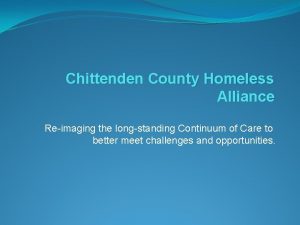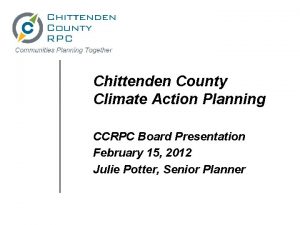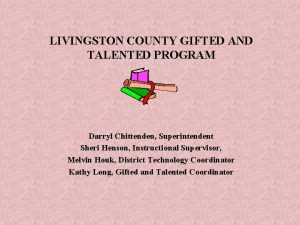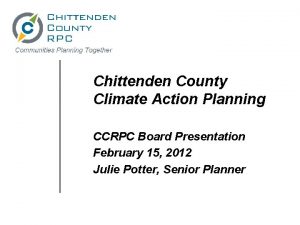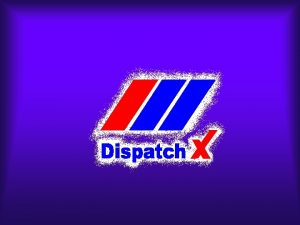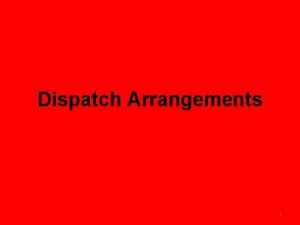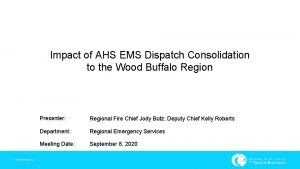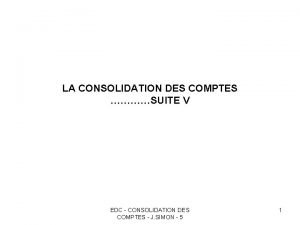Chittenden County Regional Dispatch Implementation Dispatch Consolidation Roadmap









































- Slides: 41

Chittenden County Regional Dispatch Implementation Dispatch Consolidation Roadmap

Agenda 1. Welcome and introductions 2. Why are we doing this? 3. DELTAWRX Report a. Consolidation b. Future State 4. Governance Work Group 5. Proposed next steps 6. Questions? Dispatch Consolidation Roadmap

Welcome & Introduction q Presenting the results of DELTAWRX analysis and Governance Work Group q 9 municipalities funded (Winooski, Milton, South Burlington, Shelburne, Burlington, Essex, Williston, Colchester, and Richmond) q Work involved all municipalities and planning for all public safety organizations in the county Dispatch Consolidation Roadmap Page 3

PSAP Map Public Safety Answering Points Why are we doing this? Dispatch Consolidation Roadmap

DELTAWRX experience… q Total public safety/criminal justice projects: 150+ q Public safety engagements with regional consortiums: 28 q Dispatch consolidation engagements: 14 q Hamilton County, Indiana: Assisted a multi-jurisdictional public safety communications center stabilize operations after rapid consolidation; conducted operational assessment of communications center q Metro Transit, Minnesota: Developed implementation plan to stand up a new public safety dispatch center to support police dispatching operations q Santa Clara County and the Cities of San Jose, Mountain View and Palo Alto, California: Analyzed the advantages and disadvantages to service delivery and the financial implications of creating a dedicated Fire/EMS dispatch center, versus the status quo of dispatching these resources from within existing Police Departments Dispatch Consolidation Roadmap

Dispatch Consolidation Roadmap January 31, 2017

Contents q Consolidation: A New Dispatch Paradigm q Recommended Future State Dispatch Consolidation Roadmap Page 7

Background q Our proposed plan is the result of a participatory and interactive process n Interviews with 60+ individuals from project sponsor agencies, the Vermont State Police, Vermont Enhanced 9 -1 -1 Board and Cross. Wind Technologies n Builds on the preferences, assumptions and requirements agreed upon during an interim workshop in November, including the desire to pursue full consolidation among the project sponsors n Continuously refined to take into account the ongoing efforts of the Governance Work Group q The objective of this presentation is to n Describe how consolidation will impact the current environment n Document the state of the future Chittenden County consolidated communications center Dispatch Consolidation Roadmap Page 8

Consolidation Overview A NEW DISPATCH PARADIGM Dispatch Consolidation Roadmap

Understanding Dispatch Consolidation q In this presentation, the term “consolidated dispatch” means more than transferring individual communities’ dispatchers to a single facility; it reflects modernizing the method for processing emergency calls q The recommended service delivery model improves the efficiency with which resources are dispatched to life threatening emergencies n Dispatchers use the Computer Aided Dispatch (CAD) system as a decision support tool, as opposed to as a record keeping log, in order to enter calls, dispatch units and manage incidents more efficiently and effectively Call processing business practices are streamlined n Emergency communications is a service driven entity, with paying law enforcement, fire and emergency medical services customers “Non-communications” tasks are handled by Police Department personnel Dispatch Consolidation Roadmap Page 10

Common Benefits of Centralized Dispatch Models q Common platform n Facilitates inter-agency communication n Enables a coordinated response, including sending the closest, most appropriate resource, particularly for Fire/Emergency Medical Service incidents Possible Financial Advantages • Shared capital costs • Improved likelihood for grants and federal funding in support of interoperable communications q Staffing advantages n Pooled, cross-trained resources ease the burden of providing 24/7 coverage n Teams can share the load and prioritize incidents while maintaining high availability n Supports a dedicated Fire/Medical position for long, complex incidents q Structured, standards-based environment n More resources to contribute to supervision, quality assurance and training which supports improved accuracy n Management structure offers a career trajectory for dispatchers Dispatch Consolidation Roadmap Page 11

Consolidation Addresses Issues Specific to Chittenden County Staffing • Issue: 6 Locations have single person minimum staffing which limits the dispatcher’s ability to prioritize incidents and offers no redundancy in the event of a major emergency • Solution: Consolidation eliminates this risk through increased staffing; model also positively impacts staffing by creating time for supervision, quality assurance, ongoing training and after action reporting and by offering career advancement opportunities Mutual Aid • Issue: Mutual aid is requested through a manual, sequential process which lengthens call processing times • Solution: Consolidation minimizes this issue by providing a collective view of participating agencies’ resource availability and allowing CAD to systematically select the most appropriate resource based on pre-defined parameters; on occasion external resources will still be required Dispatch Consolidation Roadmap Page 12

Consolidation Addresses Issues Specific to Chittenden County Fire/EMS Calls • Issue: There is no dedicated oversight during Fire/EMS calls for service, posing a risk to first responder safety • Solution: Consolidation eliminates this issue by creating a fire operations position(s) consistent with NFPA guidelines; further, associated improvements in technology will help bring Fire/EMS dispatching in line with industry standards Call Taking Process • Issue: PSAPs transfer calls to Dispatch Centers, lengthening the call taking process* • Solution: Consolidation minimizes this issue by transitioning dispatch centers into a PSAP and thus assuming call answering duties (a small percentage of calls will still be transferred) * Shelburne is already a PSAP and therefore an exception Dispatch Consolidation Roadmap Page 13

Becoming a PSAP Shortens the Call Taking Process q CCRPC estimates that the PSAP transfer adds an average of 90 extra seconds per 911 call q The NFPA recommends that 80% of calls are processed within 60 seconds and that 95% of calls are processed within 106 seconds Current Process Citizen Dials 911 PSAP Answers Call PSAP Transfers Call to PD PD Answers Call Processing Occurs Units Dispatched Units Arrive Multiple Manual Steps Future Process Citizen Dials 911 PSAP Answers Call Processing Occurs Dispatch Consolidation Roadmap Page 14

Countywide Consolidation Decreases Staffing Requirements q Personnel costs account for about 93% of dispatch expenses in the current environment and are thus a key metric in financial analysis q Dispatch centers are currently authorized to employ 45 FTE n Consolidation model requires up to 38 FTE (conservative staffing) n 45 – 38 = 7 FTE q The reduction of 7 FTE can occur through natural attrition n Dispatcher turnover is about 8%/year, low by national standards n 38 FTE * 8% = Loss of 3 FTE per year through natural attrition n Some dispatchers may opt out of moving to the consolidated entity q 6 Police Departments will need to reassign non-communications duties currently performed by dispatchers n This will require between 0 -6 FTE, depending on existing capacity, for a net “savings” of 1 -7 FTE These duties may be able to be covered by existing Police Department employees Dispatch Consolidation Roadmap Staffing temporarily increases during first phase of the transition period Page 15

Full Consolidation Saves Countywide Personnel Costs Estimated Personnel Savings (Annual) $450, 000 $400, 000 $350, 000 $300, 000 $250, 000 $200, 000 $150, 000 $100, 000 $50, 000 $0 0 1 2 3 FTE Backfill 4 5 6 q Excludes transitional staffing period Dispatch Consolidation Roadmap Page 16

Consolidation Challenges Challenge Mitigation Strategy Organizational Change Posed to Dispatchers are integral to the process, must be respected as professionals and thoughtfully involved: communicate transparently, address rumors, invest in transition training and create a forum for pre- and post-cutover feedback Pay and Benefit Considerations Consider current bargaining agreements, workload, experience, technology and complexity in developing a competitive compensation package Standardization Agency chiefs must be prepared to compromise: with few exceptions, SOPs that cannot be uniquely configured in CAD should be standardized Operational Changes In addition to changes in the Communications Center, field personnel will need to change how they conduct daily operations (e. g. , radio usage) Differing Perspectives on Technology Prioritize “must have” functionality over a given vendor and leave the door open for future changes Dispatch Consolidation Roadmap Page 17

Consolidation Challenges Challenge Mitigation Strategy Leadership Adequately fund the Executive Director position and begin recruiting early: this leader must be perceived as competent, fair and strong and available to support the transition Emergency Service and Governance structure must be perceived as fair by all parties Community Equity and provide a voice for smaller communities Loss of 24 x 7 Communication: Assure community members that public safety Administrative Desk at emergency services will remain available around the clock and the Police Departments that they will benefit from improved service delivery; educate citizens on administrative services that will be reduced to business hours; seek after-hours self-service solutions (e. g. , exterior form box) Dispatch Consolidation Roadmap Page 18

Description of the Future State CHITTENDEN COUNTY PUBLIC SAFETY COMMUNICATIONS AUTHORITY Dispatch Consolidation Roadmap

Organizational Overview q Chittenden County Public Safety Communications is dubbed “CC- COMM” in this presentation for convenience q CC-COMM requires the participation of the City of Burlington and at least one other community with a 7 x 24 dispatch center to achieve the scale necessary to launch q CC-COMM will ultimately function as a PSAP and thus benefits significantly from the resources that Shelburne brings to the table n Improves service delivery while supporting the entity’s financial viability q The greater the participation, the greater the overall benefit q Communities are phased in to support transitional staffing, introduce organizational change gradually and address issues that arise in a lower-risk environment n Communities will maintain the status quo while they await CC-COMM service delivery (i. e. , no incremental consolidation) Dispatch Consolidation Roadmap Page 20

Timeline q The proposed timeline is best case scenario, but doable through teamwork, a commitment to compromise and clear roles and responsibilities Phase 1: July 2018 Phase 2: January 2019 Phase 3: December 2019 • Serves Burlington and one or two other communities • Functions as a dispatch center until Shelburne joins, at which time it will become a PSAP • Adds two to three other communities • Operates from the ultimate facility • Adds final project sponsor communities • Poised to add other communities on a contract-forservice basis once operations have stabilized • Could begin from existing facility Dispatch Consolidation Roadmap Page 21

Phase 1. Burlington + 2 Communities Shift Supervisor BPD Dispatch PSAP Law C/T Dispatch Fire/EMS C/T Dispatch CC-COMM CFS 75, 000 CC-COMM FTE 26 Legacy Dispatch Center FTE* 23 Total FTE* 49 * Illustrative Only; Based on S. Burlington and Winooski Key Tactical Director Dedicated Position Staffed 24 x 7 x 365 Role Filled on Demand Training and QA Systems Support Dispatch Consolidation Roadmap Administrative Schedule: M-F Days Page 25

Phase 2. Add Shelburne + 1 Other Community Shift Supervisor BPD Dispatch Reporting Party Law C/T Dispatch Fire/EMS C/T Dispatch CC-COMM CFS 90, 000 CC-COMM FTE 32 Legacy Dispatch Center FTE* 12 Total FTE* 44 * Illustrative Only; Based on Shelburne and Williston Key Tactical Director Dedicated Position Staffed 24 x 7 x 365 Role Filled on Demand Training and QA Systems Support Assistant Dispatch Consolidation Roadmap Administrative Schedule: M-F Days Page 26

Phase 3. Add Final 3 Communities Shift Supervisor BPD Dispatch Reporting Party Law C/T Dispatch Fire/EMS C/T Dispatch FD/EMS Dispatch Ops CC-COMM CFS 135, 000 CC-COMM FTE 38 Legacy Dispatch Center FTE 0 Total FTE 38 Key Tactical Director Dedicated Position Staffed 24 x 7 x 365 Role Filled on Demand Training and QA Systems Support Assistant Dispatch Consolidation Roadmap Administrative Schedule: M-F Days Page 27

Potential Roles and Responsibilities Executive Board City and Town Managers Establish CC-COMM governance structure, bylaws and cost allocation method, approve annual budget, handle labor issues, hire and oversee ED, oversee Technical Advisory Committee Subset of Agency Chiefs Create and staff subcommittees, make technical and operational decisions that impact service delivery Police Ops Subcommittee Subset of Senior Law Personnel Make operational policy recommendations CC-COMM Executive Director (ED) Fire/EMS Ops Subcommittee Subset of Senior Fire/EMS Personnel Make operational policy recommendations Administrative Work Group Subset of City and Town Leadership Develop HR plan, draft ED job description and administrative SOPs *Duties will ultimately shift to ED Radio Subcommittee Subset of Senior Agency Personnel Make technical and usage recommendations Dispatch Consolidation Roadmap Others As Needed ? Page 28

Implementation Overview Part 1: Formulation and Research • Begin developing the organizational entity • Research CAD and identify the optimal path forward • Initiate standardization discussions • Begin preparing initial documentation (preliminary agreement, salary survey, human resources plan) Part 2: Refinement and Detailed Planning • Pursue CAD path • Prepare detailed documentation (service level agreement, radio communications plan) • Inventory existing equipment • Recruit and hire Executive Director Part 3: Execution Part 4: Transition • Configure and test CAD, interfaces and other systems • Prepare to reroute emergency calls • Outfit the facility and backup facility as necessary • Hire and train initial employees • Train communications staff and first responders • Cutover through phased approach • Transition to a PSAP • Initiate ongoing organizational improvement tasks Dispatch Consolidation Roadmap Page 29

Questions? Liz Coyle Donald Denning lcoyle@deltawrx. com ddenning@deltawrx. com Dispatch Consolidation Roadmap

Governance Work Group q Governance? ? ? q 1967 Study: Greater efficiencies at least possible cost, eliminate duplication , and pool information Dispatch Consolidation Roadmap

Governance An Act to provide for research into problems of flight within and outside the earth's atmosphere, and for other purposes. NATIONAL AERONAUTICS AND SPACE COUNCIL NATIONAL AERONAUTICS AND SPACE ADMINISTRATION FUNCTIONS OF THE ADMINISTRATION CIVILIAN-MILITARY LIAISON COMMITTEE INTERNATIONAL COOPERATION REPORTS TO THE CONGRESS NATIONAL ADVISORY COMMITTEE FOR AERONAUTICS TRANSFER OF RELATED FUNCTIONS ACCESS TO INFORMATION SECURITY PROPERTY RIGHTS IN INVENTIONS CONTRIBUTIONS AWARDS APPROPRIATIONS Dispatch Consolidation Roadmap

Governance Work Group Goal: Evaluate and recommend ideal governance structures Public Safety Participants: • • Fire/Rescue (Urban): Steve Locke, Burlington Fire Chief Police Jan Wright, Burlington Deputy Police Chief Police: Brad Larose, Essex Police Chief Police: Trevor Whipple, South Burlington Police Chief Fire (Volunteer): Steve Bourgeois, Malletts Bay Fire Chief Fire (Volunteer): Al Barber, Hinesburg Fire Chief Rescue (Volunteer): Dan Manz, Essex Rescue Chief Dispatch: Jeff Barton: Colchester Police Lieutenant City/Town Leadership & Regional Planning Participants • • • Charlie Baker & Lee Krohn, CCRPC Joe Colangelo and Ann Janda, Shelburne Kevin Dorn & Tom Hubbard, South Burlington Miro Weinberger, Burlington Mayor Ray Coffey, Winooski Donna Barlow Casey, Milton Rick Mc. Guire, Williston Dawn Francis and Aaron Frank, Colchester Geoffrey Urbanik, Richmond 8 meetings since late October, 2016 Dispatch Consolidation Roadmap Page

Governance Issues 1. Legislative/Enabling Authority 2. CEO and board of directors 3. Voting and financial contributions 4. Long term debt capacity 5. Authority to enter collective bargaining agreements 6. Responsibility to and for employees 7. Stakeholder/customer satisfaction 8. Authority to bind contracts 9. Leverage existing support functions: HR, finance, risk management and insurance, budgeting, buildings, IT infrastructure, telecom 10. Capacity To grow/expand 11. Coordination across County Dispatch Consolidation Roadmap Page

Models Examined 1. Inter-municipal contracting 2. Regional special purpose government w/ legislative charter 3. Intermunicipal service agreement with CCRPC 4. Non-profit under CCRPC 5. Non-profit formed by Municipalities 6. Interlocal police services organization 7. Union municipal district – RECOMMENDED Review included Municipal & CCRPC legal counsel Dispatch Consolidation Roadmap Page

Union Municipal District - 24 VSA Ch. 121, Sub. 3 Benefits: • Legislative power (enforceable ordinances): • • • Alarm ordinances for businesses Prosecution of false 911 calls and or reports to police Future: animal control, etc. • Borrow at low government rates • Apply directly for grants • Government immunity • Less complex governance structure • No need for State legislative approval of charter • Could expand to cover other public safety support services • • • No Police, Fire and Rescue without another vote Possibly CUSI, animal control, technical rescue, detective services Joint Survey Committee (pre-public vote board) authorized to • Research technical issues and solutions: location, software, equipment, phasing • Draft charter, bylaws, funding mechanisms • Develop organization with funding from Cities/Towns • Develop public information Dispatch Consolidation Roadmap Page 36

Union Municipal District - 24 VSA Section 4345 b Challenges: • Will require a significant communications effort to explain to voters. • Hire executive director and incur other expenses in advance of go live date. • Vote of voters to join makes earliest start date 7/1/2018 • Significant work ahead to ready organization for vote & operations • Charter, Budget, Assessments • Common protocols, software, equipment • Staffing, training, testing Other union municipal districts include: CCTA (GMT), CSWD, CWD Dispatch Consolidation Roadmap Page

Union Municipal District : Overall Advisory Committee with reps from: 10 Police Chiefs 18 Fire Chiefs Executive Board (5 -8 appointed) by Communities now providing dispatch 10 Rescue Chiefs Assessments to 5 -8 Member Towns Executive Director 2 -3 Shift Supervisors also fill in Dispatch IT/Telecom Training & QA/QC (Alarms/DPS Software/ Hardware/Integration) (Software Expert/Interface) 5 cross trained dispatchers: BPD Dispatch Police Dispatch Backup Dispatch Fire/EMS Dispatcher 32 -38 total staff based on DWRX interim report Fire/EMS Ops Page 38

Union Municipal District: Governance Executive Board (5 -8 appointed) Advisory Committee w/ reps from: 10 Police Chiefs 18 Fire Chiefs • • • 10 Rescue Chiefs • • • Executive Director • Hire Communications Director Budget Vote Long Term Commitments with 5 -8 Communities with Dispatch Fees for service ($/call) with other Towns Pay, benefits and human resources Debt obligations through long term contracts with member communities only Vendor Contracts Regional Planning Commission staff coordinating and contracted support • GIS • Finance • Intergovernmental Coordination/Facilitation/Open meetings • Support Advisory Committee Page 39

Next Steps - Organizing q Feb/March 2017 – Meet with Towns operating dispatch services n Make appointment to Joint Survey Committee q Feb 2017 – Technical Advisory Committee starts meeting q Feb/March 2017 – Meet with rest of Towns to provide update q March 2017 – Organize Joint Survey Committee q March 2017 – Begin ongoing informational meetings with dispatchers q Spring 2017 - CCRPC Bylaws approved to enable offering services to Joint Survey Committee Dispatch Consolidation Roadmap Page 40

Next Steps - Development q Spring 2017 – draft Charter for union municipal district q Summer 2017 - draft budget and assessments prepared for proposed members (those who appoint Joint Survey Committee members) and contract fee rates for others q Fall 2017 – obtain commitment of Joint Survey municipalities to fund part time and/or interim Exec Director in FY 18 via contract with CCRPC q Fall/Winter 2017 – communications to participating towns in preparation for Town Meeting Day votes q Winter 2017 – Joint Survey Committee hires interim Exec Director through contract with CCRPC: find space; arrange support services; integrate of radio systems, telecom, and upgrade CAD; benefits and pay; operating procedures; plan of dispatch agency integration; redundancy and testing plans Dispatch Consolidation Roadmap Page 41

Next Steps - Decisions q Winter 2017 -2018 - Towns committed to vote on regional entity will propose funding for dispatch services in their FY 19 budgets, in such a manner that it could go to the new regional entity (if the Town votes to join) or to retain service in house (if the Town votes not to join). q Spring 2018 - Town Meeting votes on membership q Spring 2018 - Determine costs, assessment and onboarding plan (which municipal dispatch centers close when) that works based on actual members q April 2018 - Municipal members cede dispatching authority per onboarding plan q April 2018 - Begin to hire employees in a staggered manner to set up and test systems, leave municipal ops in place but build team q July 1, 2018+ - Agency begins providing dispatch services to at least one communities who voted to join and continue to onboard per plan Dispatch Consolidation Roadmap Page 42

Moving forward q It is hoped that all Chittenden County municipalities ultimately participate in the regional dispatch entity q Cities and Towns that operate dispatch services n Further explore becoming members in union municipal district dispatch entity m Appointment to the Joint Survey Committee. q Other communities would have fees for service and representation through an advisory committee of public safety chiefs q Mix of funding and commitments will help keep the regional dispatch entity focused on both service and quality Dispatch Consolidation Roadmap Page 43

THANK YOU! Questions? For more information, contact: n n Charlie Baker, cbaker@ccrpcvt. org or 735 -3500 Joe Colangelo, jcolangelo@shelburnevt. org or 985 -5111 Aaron Frank, AFrank@colchestervt. gov or 264 -5509 Lee Krohn, lkrohn@ccrpcvt. org or 861 -0118 Work to date can be found at: n http: //www. ccrpcvt. org/our-work/emergency-management/regional-dispatch/ Dispatch Consolidation Roadmap
 Bruce chittenden
Bruce chittenden Bruce chittenden
Bruce chittenden The greeps
The greeps Master data management plan
Master data management plan Inherent risks examples
Inherent risks examples Office 365 implementation roadmap
Office 365 implementation roadmap Office 365 implementation
Office 365 implementation Northern burlington county regional school district
Northern burlington county regional school district Warren county regional jail inmates
Warren county regional jail inmates Rpc champaign il
Rpc champaign il 5988 e
5988 e Solaris dispatch table
Solaris dispatch table Solaris dispatch table
Solaris dispatch table Emergency medical dispatch guidecards
Emergency medical dispatch guidecards Ambulance dispatch system requirements specification
Ambulance dispatch system requirements specification Central dispatch
Central dispatch Hytera smart dispatch manual
Hytera smart dispatch manual Dispatch anywhere mobile
Dispatch anywhere mobile Grand central dispatch c++
Grand central dispatch c++ Labour dispatch system
Labour dispatch system Wildcad prescott
Wildcad prescott Ch robinson dispatch
Ch robinson dispatch Automated dispatch system
Automated dispatch system Dynamic method dispatch in java javatpoint
Dynamic method dispatch in java javatpoint Dispatch service for hotshot
Dispatch service for hotshot Double dispatch
Double dispatch Mototrbo dispatch software
Mototrbo dispatch software Ortec routing and dispatch
Ortec routing and dispatch Seven state process transition diagram
Seven state process transition diagram Accessible dispatch
Accessible dispatch Thc and fitness
Thc and fitness Centrale dispatch kuleuven
Centrale dispatch kuleuven Dispatch
Dispatch Butler model
Butler model Web server consolidation
Web server consolidation Fracture bifocale définition
Fracture bifocale définition Consolidation of stressors
Consolidation of stressors Consolidation of gains
Consolidation of gains Consolidation techniques and procedures
Consolidation techniques and procedures Partial equity method consolidation worksheet
Partial equity method consolidation worksheet What is merger and consolidation
What is merger and consolidation Equity method vs proportionate consolidation example
Equity method vs proportionate consolidation example





